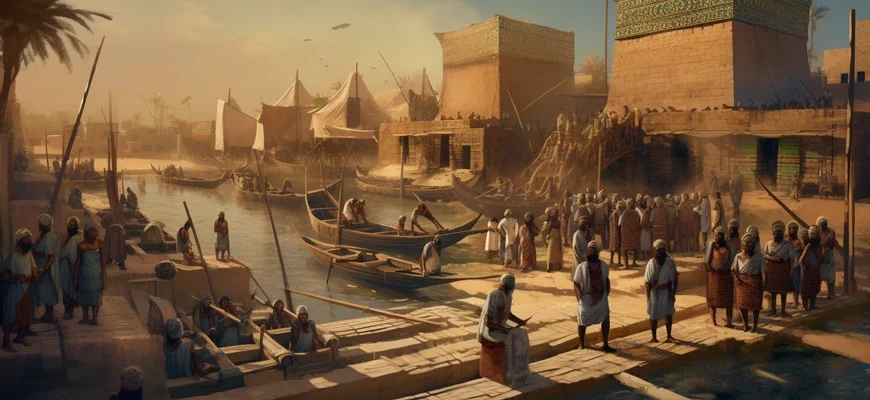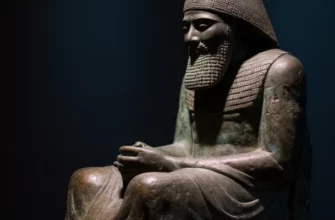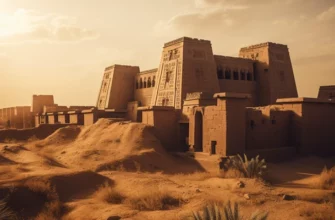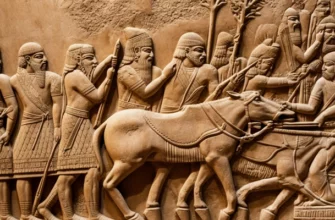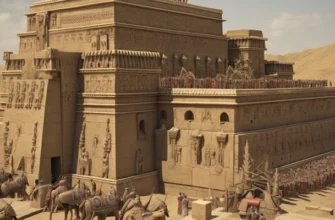The Sumerians were one of the oldest civilizations in the world, developing in what is now Iraq near the Euphrates River in the 4th-3rd millennium BC. The environment and geographical location had a major impact on the lives of the Sumerians.
In ancient times, the Sumerians were located in the Euphrates River delta, not far from the Persian Gulf. This area was very fertile, which allowed the Sumerians to develop agriculture. The climate was quite favorable for agriculture, as the area experienced periodic flooding, which provided sufficient moisture for plant growth. There were also a large number of rivers in the area, which provided access to water for irrigating the fields.
Sumerian civilization developed in the middle reaches of the Euphrates River, which allowed them to engage in trade and establish ties with other civilizations. On the other hand, the territory where the Sumerians developed was remote from sea routes, which limited their contact with other peoples living on the coast. However, the Sumerians were distinguished by a high level of cultural and scientific development, which testifies to the high level of intellectual development of this civilization.
Features of Sumerian culture related to the terrain and climate
The terrain and climate of the territory where the Sumerians developed influenced the formation of the characteristics of their culture. Here are some of them:
Agriculture: The fertile terrain of the territory contributed to the development of agriculture, which was the main branch of the Sumerian economy. They learned how to grow crops such as barley, wheat, and millet from the surrounding fertile land, which became their main food sources.
Trade: The favorable geographical location of the Sumerians allowed them to develop trade with other civilizations. Thanks to the rivers and the Euphrates delta, the Sumerians became an important trading point for trade with countries to the east and west. They traded gold, silver, pearls, coal, textiles, and other valuable items.
Construction: The terrain of the Sumerians was flat, which facilitated the development of construction. They built huge temples, palaces, and other monumental buildings using ceramics, paving stones, and clay.
Religion: The Sumerians had a multifaceted religious culture. They believed in a diverse pantheon of deities who controlled various aspects of people’s lives, such as agriculture, war, and science. Their religious beliefs also reflected the influence of the climate of the territory where they lived, and in particular their dependence on floods and other natural conditions.
Residential buildings: The climatic conditions of Sumer required the construction of houses that provided protection from the heat in summer and the cold in winter. Therefore, their residential buildings were constructed of clay and were low-rise, with flat roofs that allowed water to be collected during rain.
Floods: Floods on the Euphrates and Tigris were a frequent occurrence that affected the lives of the Sumerians. They developed a special system of canals and irrigation to ensure their harvests. In addition, floods were also associated with religious rituals, as for the Sumerians they symbolized a change in the natural order.
Harsh natural conditions: Living in harsh natural conditions forced the Sumerians to develop a high level of organization and management. They created a complex system of government that included local governments, central authority, and a system of laws and justice.
All these features of Sumerian culture are related to the terrain and climate of the territory in which they developed. They reflect how people adapted to life in difficult conditions and developed their culture, which remains a subject of study for modern historians and archaeologists.
The influence of the Euphrates and Tigris rivers on the development of Sumerian civilization
The Euphrates and Tigris rivers had a huge influence on the development of Sumerian civilization. These rivers were the main source of water and an essential element in the economic life of the ancient Sumerians. Here are some of the main ways in which the rivers influenced the development of civilization:
Providing water for agriculture: The Sumerians developed an irrigation and watering system to provide water for their agricultural land. The Euphrates and Tigris rivers provided a huge supply of water, which was used to irrigate the land and ensure crops.
Transportation: The Euphrates and Tigris rivers were important transportation routes for the Sumerians. They allowed people and goods to be transported along the rivers, facilitating trade and the exchange of resources between different parts of the country.
Urban development: The Euphrates and Tigris rivers were also an important element in the development of cities. The Sumerians built their cities on the banks of rivers, which provided access to water for drinking, food, and other needs.
Provision of building materials: The Euphrates and Tigris rivers provided the Sumerians with many useful resources, including clay and plant materials, which were used to construct residential buildings and infrastructure.
Religion: Sumerian religion contained many myths and legends associated with the Euphrates and Tigris rivers. The rivers symbolized life and death and were also associated with the cult of water and earth. Many of the festivals and rituals of the Sumerian religion included rituals associated with rivers, such as the festival of Abbu, which was celebrated at the beginning of the new year and was associated with the purification of water.
Thus, the Euphrates and Tigris rivers played an important role in the development of Sumerian civilization, providing water for irrigation, transportation, and trade, as well as materials for construction and religious rituals.
The structure of Sumerian society and its relationship with the environment.
The structure of Sumerian society was diverse and complex. At the top of the social hierarchy were the rulers of city-states, who controlled the political and economic life of the country. They were also military leaders who defended the cities from external attacks.
Below them in the hierarchy were priests and worshippers, who played an important role in the religious life of the country. They were intermediaries between people and deities, performing rituals and ceremonies that helped to ensure harmony in nature and human life.
The lowest class of society consisted of farmers and artisans who produced goods and worked the land. They made up the majority of the population of city-states.
The structure of Sumerian society was deeply connected to the environment. For example, food production and crafts were the basis of the country’s economy. The climate and terrain determined the location of city-states and the development of irrigated agriculture.
In addition, the Euphrates and Tigris rivers provided transportation and trade between city-states. Sumer’s location on the ridge between the rivers made it a strategically important place for controlling trade and military operations in the region.
Thus, the structure of Sumerian society was closely linked to the environment and reflected the role of rivers, climate, and terrain in the economic, social, and political life of the country. Relations between classes were quite complex, but there was a certain stability that helped ensure the continuity of society.
The role of the Euphrates and Tigris rivers in the development of Sumer was important not only from an economic and political point of view, but also in the cultural and religious life of the country. Sumerian religion, for example, is connected with nature and, for the most part, with the Euphrates River. Beliefs in the god of water (Enki) and the goddess of earth (Ki) were linked to the fertility of the land and the river’s ability to irrigate the fields.
The Euphrates and Tigris rivers were also important locations for Sumerian architecture and art. Many of the most famous structures, such as ziggurat temples, palaces, and floodgates, were built near rivers. In some cases, such as that of Gilgamesh, the legendary hero of the epic, the Euphrates and Tigris were symbols of a journey to the center of the world and an encounter with the gods.
Thus, the Euphrates and Tigris rivers were significant not only as important economic and political factors in the development of Sumer, but also as a defining element of its culture and religion.
